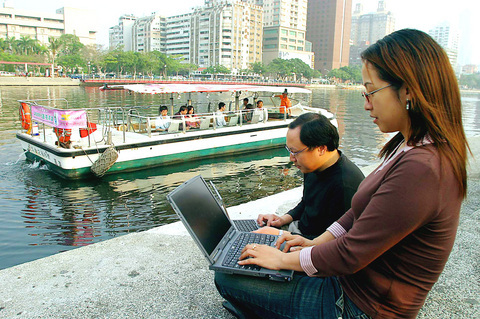Claiming to be the nation's first "real" mobile city, Kaohsiung City yesterday inaugurated wireless Internet connections in parts of the city to provide free access in the public.
"I believe the wireless infrastructure will bring more benefits to our people and visitors," Kao-hsiung Mayor Frank Hsieh (

PHOTO: CHANG CHUNG-YI, TAIPEI TIMES
Hsieh tested the system while riding a boat on Kaohsiung's landmark Love River, and he said "the result is excellent ... the connection speed is faster than the broadband system I use at home."
The wireless service is currently available in or near the city government building, the City Council, the Cultural Center and Hsinkuang Wharf, said Tony Wu (吳國棟), chief operation officer of Easpnet Taiwan Inc (數位通國際網路). Easpnet became the contractor for the project after winning the bid in October.
By the end of next April, the service will be extended to downtown Lingya, Shinshing and Chienchin Districts. Kaohsiung's other eight districts will receive the service by the end of next year, giving the city 80 percent coverage, Wu said.
The mobile city project will cost the Kaohsiung City Government an estimated NT$93 million, Wu said. The service will be free for one year after the entire project is completed, or from the end of next year, he said.
The system will also be used to improve security. The wireless connection is linked to monitoring systems set in crossroads, a digital fire alert system, and a vehicle tracking system, which allows the police force and fire department to obtain information instantly.
The Taipei City government also has a similar plan to bring wireless connection to the whole city by the end of next year.
The government is currently testing the system in the area around the Taipei City Government building in Hsinyi District. By the end of this year, the service will be officially launched along 20 Mass Rapid Transportation stations.
The wireless infrastructure, however, has reportedly been less well received than expected by Taipei residents due to compatibility problems.
The Taipei City Government contracted different companies to build the wireless system in different areas. State-run Chunghwa Telecom Co (中華電信) covers the general Hsinyi District, Qware Systems Inc (安源資訊) is in charge of MRT stations, while restaurants and coffee shops have their own wireless service providers, forcing users to apply for another user account when they enter another area.
One official at Easpnet who did not want to be named said this problem will not occur with Kaohsiung's wireless network. However, he acknowledged that access there is still not completely stable due to signal interference in the area.
The company will streamline this later to make the system run more smoothly, he said.

Taiwan Semiconductor Manufacturing Co (TSMC, 台積電) last week recorded an increase in the number of shareholders to the highest in almost eight months, despite its share price falling 3.38 percent from the previous week, Taiwan Stock Exchange data released on Saturday showed. As of Friday, TSMC had 1.88 million shareholders, the most since the week of April 25 and an increase of 31,870 from the previous week, the data showed. The number of shareholders jumped despite a drop of NT$50 (US$1.59), or 3.38 percent, in TSMC’s share price from a week earlier to NT$1,430, as investors took profits from their earlier gains

In a high-security Shenzhen laboratory, Chinese scientists have built what Washington has spent years trying to prevent: a prototype of a machine capable of producing the cutting-edge semiconductor chips that power artificial intelligence (AI), smartphones and weapons central to Western military dominance, Reuters has learned. Completed early this year and undergoing testing, the prototype fills nearly an entire factory floor. It was built by a team of former engineers from Dutch semiconductor giant ASML who reverse-engineered the company’s extreme ultraviolet lithography (EUV) machines, according to two people with knowledge of the project. EUV machines sit at the heart of a technological Cold

Taiwan’s long-term economic competitiveness will hinge not only on national champions like Taiwan Semiconductor Manufacturing Co. (TSMC, 台積電) but also on the widespread adoption of artificial intelligence (AI) and other emerging technologies, a US-based scholar has said. At a lecture in Taipei on Tuesday, Jeffrey Ding, assistant professor of political science at the George Washington University and author of "Technology and the Rise of Great Powers," argued that historical experience shows that general-purpose technologies (GPTs) — such as electricity, computers and now AI — shape long-term economic advantages through their diffusion across the broader economy. "What really matters is not who pioneers

TAIWAN VALUE CHAIN: Foxtron is to fully own Luxgen following the transaction and it plans to launch a new electric model, the Foxtron Bria, in Taiwan next year Yulon Motor Co (裕隆汽車) yesterday said that its board of directors approved the disposal of its electric vehicle (EV) unit, Luxgen Motor Co (納智捷汽車), to Foxtron Vehicle Technologies Co (鴻華先進) for NT$787.6 million (US$24.98 million). Foxtron, a half-half joint venture between Yulon affiliate Hua-Chuang Automobile Information Technical Center Co (華創車電) and Hon Hai Precision Industry Co (鴻海精密), expects to wrap up the deal in the first quarter of next year. Foxtron would fully own Luxgen following the transaction, including five car distributing companies, outlets and all employees. The deal is subject to the approval of the Fair Trade Commission, Foxtron said. “Foxtron will be